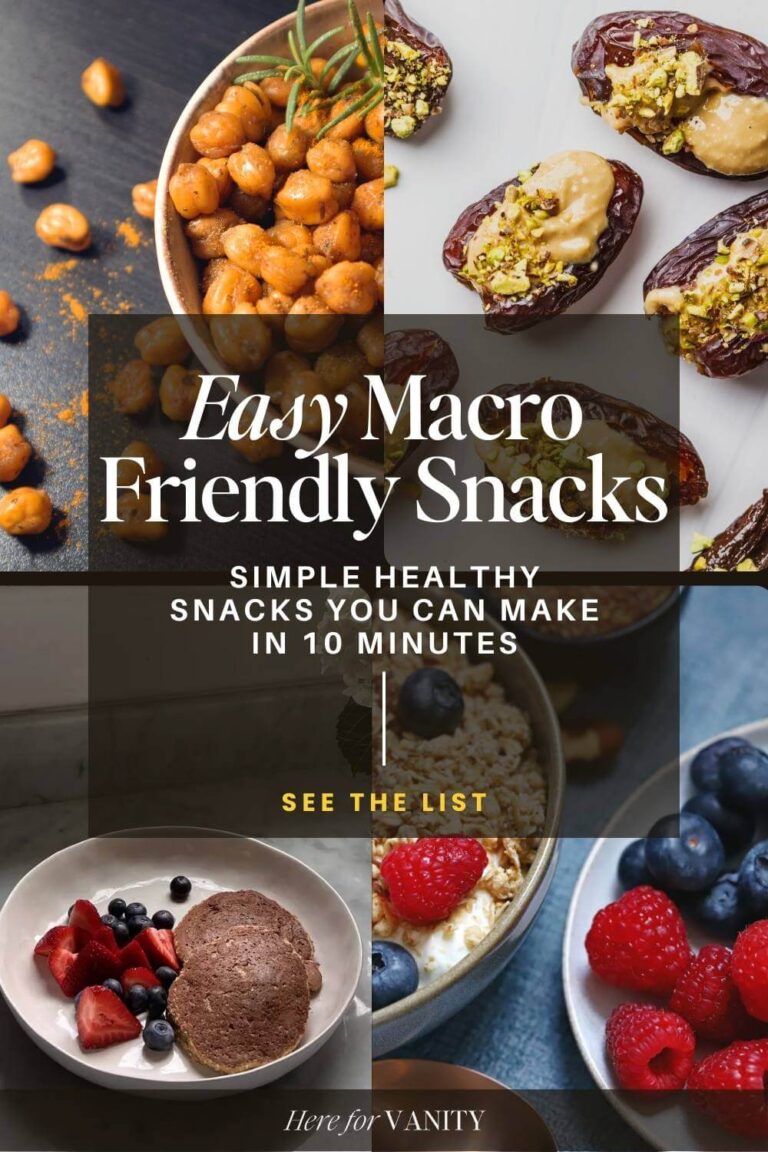The Ultimate Weight Training Routine for Women Over 40
This program focuses on weight training for women over 40, aimed at helping you build strength, boost your metabolism, and transform how you feel and move each day.
As women age, maintaining muscle mass and strength becomes even more critical due to natural hormonal shifts and the gradual loss of muscle that starts in your 30s and 40s.
Strength training can also significantly improve bone density, which is crucial for women over 40 to reduce the risk of osteoporosis. Unfortunately, this is also when life is most hectic—balancing kids, work, and home responsibilities can make pushing training aside for other priorities easy.
But what if we made it simple enough to fit into your weekly routine?
Many women over 40 also find that weight training reshapes their bodies, enhances their mental health, and boosts self-esteem. So, let’s get started!
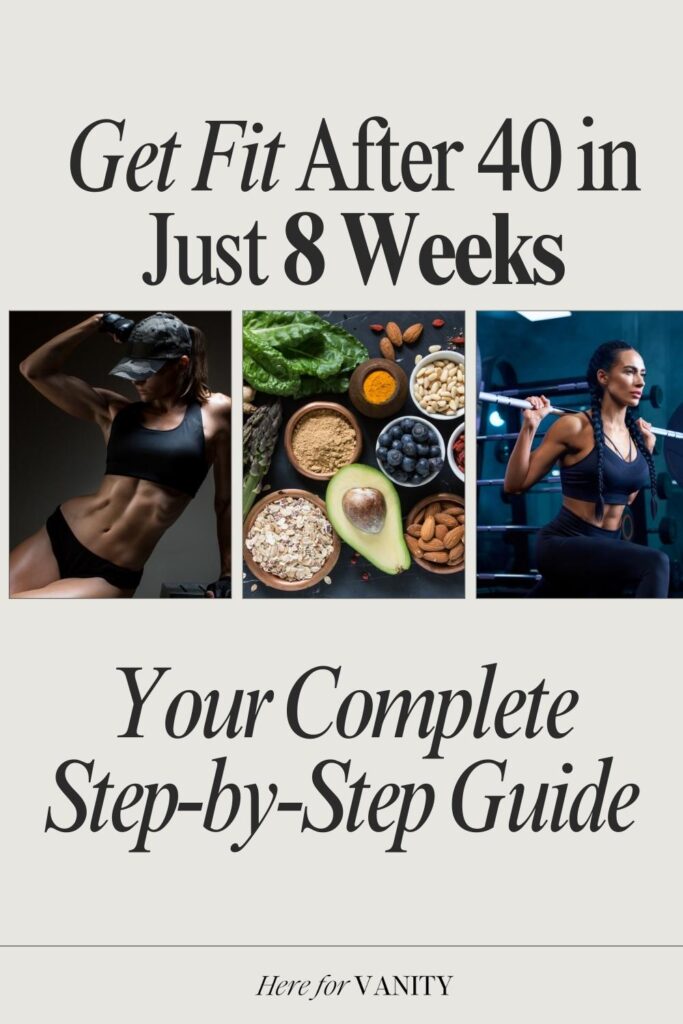
What Makes a Good Weight Training Routine?
Good news: the best weight training routines don’t need to be complicated—they focus on the basics. You don’t need an overly complex plan to see results.
A great routine is built around a core set of simple, repeatable movements that target all your major muscle groups. Think squats, deadlifts, presses, and rows.
These exercises are effective because they engage multiple muscles simultaneously, maximizing efficiency and helping you progress faster (we’ll cover more shortly).
At the heart of any good routine is the principle of quality over quantity—focusing on a few key exercises done consistently and correctly leads to success.
Compound Movements: The Backbone of Strength & Muscle Growth
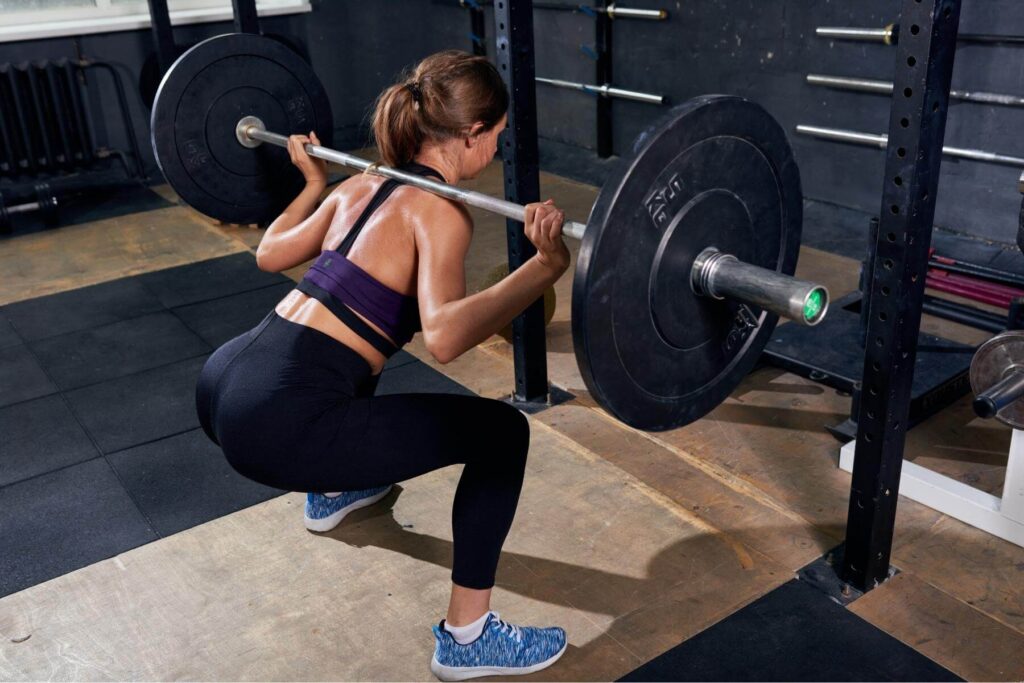
Compound movements are your heavy hitters. They target multiple muscles at once with exercises like squats, deadlifts, lunges, presses, rows, and pull-ups.
These moves save time and improve functional strength, making everyday tasks easier—carrying groceries, lifting your kids, or improving posture.
For women over 40, prioritizing a weight training routine with compound lifts is essential for maintaining lean muscle mass and supporting joint health.
In the “ultimate weight training routine” for women over 40, we’ll focus primarily on these compound movements to get you the best results.
Know Your Level: Beginner, Intermediate, or Advanced
Understanding your baseline fitness level is especially important for women over 40 who want to build a sustainable fitness routine.
How to Assess Your Level:
- Beginner: You’ve been consistently training for less than 6 months, OR you’ve taken a long break and getting back into a routine. You’re just starting (or re-starting) to build that foundational strength.
- Intermediate: With 6-18 months of training under your belt, you’ve established a solid foundation and are ready to challenge yourself further.
- Advanced: With over 2 years of consistent training, you’ve mastered the major lifts and are focused on refining your performance.
While we’re focusing on a beginner-friendly routine below, it’s designed to be customizable so you can make it work for you, no matter your experience level.
These strength-training exercises primarily emphasize compound movements typically performed with barbells. However, you can modify them using free weights, resistance bands, or your own body weight. Just remember to progressively increase the resistance each week.
Frequency: How Often to Train Each Muscle for Optimal Growth
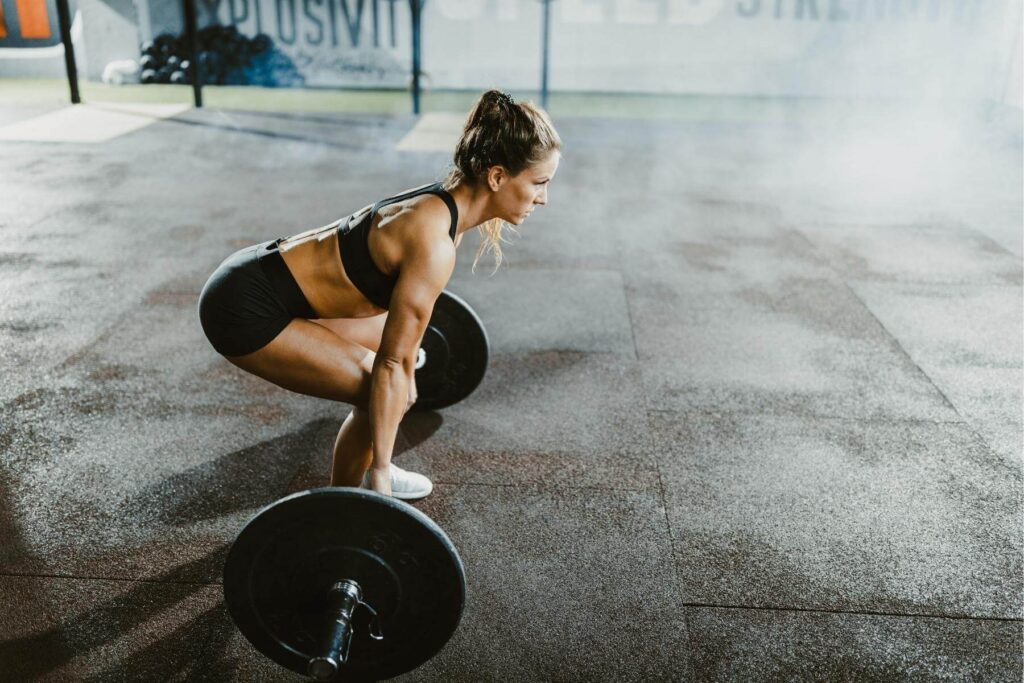
For hypertrophy (muscle growth), aim to train each muscle group 2-3 times a week, with around 10-20 total sets per muscle group.
Beginners can start with 10-12 sets per week, while more experienced lifters may increase to 15-20 sets. The key here is working in a rep range of 8-12 reps per set, with enough weight to challenge your muscles but still maintain correct form.
For muscular endurance, you’ll focus on higher rep ranges—typically 12-20 per set—with slightly lighter weights, training each muscle group with about 10-15 total sets per week.
For strength, prioritize heavier weights with lower reps (4-6 per set) and fewer total sets per week, usually 6-12 per muscle group.
The goal is to match your set and rep scheme to your desired outcome, finding that balance between pushing your muscles just enough to trigger growth, strength, or endurance without overtraining.
For this weight training routine for women over 40, we’re focusing on hypertrophy (muscle growth) because maintaining and building muscle becomes increasingly important as we age.
Workout Splits: 3 Effective Options
Remember when we talked about consistency? Your results hinge on your consistency, so it’s critical to find a routine that truly fits your lifestyle. Weight lifting is one of the most effective ways to build strength and lean muscle, especially in a structured program like this – but we have to be consistent with it.
Trust me, sticking to a plan of just two workouts a week is way better than going all in for five days one week, then barely showing up the next, and flipping back and forth with no clear structure.
I’ve included three options depending on your lifestyle. Remember, a steady plan is the key to real progress!
If you are new to weight training, start slowly and focus on good form before increasing weight. Consult a physical therapist if you have any pre-existing injuries to ensure you’re using the proper form.
3-Day Full Body Split
Overview: Perfect for beginners or anyone with a busy schedule, this full-body workout program hits all your major muscle groups in each workout, training every muscle 2-3 times a week. It’s simple, efficient, and effective.
I love the 3-day full body weight training split, especially for women over 40. Personally, I really push myself knowing I get the next day off.
This routine is designed to promote muscle growth and glute, shoulder, and back development, helping you achieve a balanced, hourglass figure.
Expect each workout to take approximately 60-75 minutes, allowing 1-3 minutes of rest between sets.
Day 1: Full Body A
- Barbell Squat: 3 sets of 8-10 reps
- Dumbbell Bench Press: 4 sets of 8-10 reps
- Barbell Row: 4 sets of 8-10 reps
- Dumbbell Shoulder Press: 4 sets of 10-12 reps
- Dumbell Lat Raises: 3 sets of 12-15 reps
- Hip Thrust or Glute Bridge: 3 sets of 10-12 reps
- Plank: 4 sets, hold for 30-45 seconds
Day 2: Full Body B
- Straight Leg Deadlift: 3 sets of 6-8 reps
- Push-ups: 4 sets of 8-10 reps
- Pull-Up (Assisted if needed): 4 sets of 6-8 reps
- Bulgarian Split Squat: 3 sets of 10-12 reps per leg
- Chest Fly (Machine or Dumbell): 2 sets of 10-12 reps
- Hanging Leg Raise: 4 sets of 10-12 reps
Day 3: Full Body C
- Goblet Squat: 3 sets of 12-15 reps
- Incline Dumbbell Press: 4 sets of 8-10 reps
- Romanian Deadlift: 3 sets of 8-10 reps
- Lat Pulldown: 4 sets of 8-10 reps
- Hip Abduction or Clamshells: 3 sets of 12-15 reps
- Face Pulls or Rear Delt Fly: 3 sets of 12-15 reps
- Russian Twists: 4 sets of 15 reps per side
Why It Works: Since you’re training your entire body each session, you can hit each muscle group multiple times per week, maximizing growth while minimizing time in the gym. Each workout uses compound movements to cover more ground in less time.
Since these are full-body workouts, take a rest day after each one to recover your muscles. Add light cardio, as desired.
4-Day Upper/Lower Split
Overview: This is ideal for intermediate lifters or for those who prefer an upper/lower split. This split divides your training into upper and lower body days, allowing for more volume on each muscle group.
Expect each workout to take approximately 60-75 minutes, allowing for 1-3 minutes of rest between sets.
Day 1: Upper Body (Push)
- Bench Press: 4 sets of 8-10 reps
- Overhead Press: 3 sets of 8-10 reps
- Incline Dumbbell Press or Pushups: 3 sets of 10-12 reps
- Tricep Extension: 3 sets of 10-12 reps
- Lateral Raises: 3 sets of 12-15 reps
- Dumbbell Chest Fly: 3 sets of 10-12 reps
Day 2: Lower Body
- Squat: 4 sets of 8-10 reps
- Romanian Deadlift: 3 sets of 8-10 reps
- Walking Lunges: 3 sets of 10-12 reps per leg
- Hip Thrusts or Glute Bridge: 4 sets of 10-12 reps
- Calf Raises: 3 sets of 15-20 reps
Day 3: Upper Body (Pull)
- Barbell Row: 4 sets of 8-10 reps
- Pull-Ups (or Assisted): 3 sets of 6-8 reps
- Face Pulls: 3 sets of 10-12 reps
- Bicep Curls: 3 sets of 10-12 reps
- Lat Pulldowns: 3 sets of 10-12 reps
- Dumbbell Rear Delt Fly: 3 sets of 12-15 reps
Day 4: Lower Body
- Deadlift: 3 sets of 6-8 reps
- Bulgarian Split Squat: 3 sets of 10-12 reps per leg
- Hamstring Curl: 3 sets of 12-15 reps
- Hip Thrusts or Glute Bridge: 3 sets of 10-12 reps
- Side-Lying Hip Abduction or Clamshells: 3 sets of 12-15 reps
Why It Works: You’ll target each muscle group twice a week, allowing for enough recovery while also giving you the flexibility to add volume or variety. This structure works well for women over 40, providing balanced recovery while keeping the intensity high enough to challenge muscle growth and strength.
5-Day Comprehensive Split
Overview: This plan is great weight training routine for advanced women lifters over 40 who want to dedicate more time to specific movements and muscle groups.
It spreads out the workload, allowing you to focus more on each part of the body while still hitting muscles 2-3 times a week. A well-structured strength training program like this one ensures balanced muscle development and consistent progress.
Expect each workout to take approximately 60-90 minutes, allowing 1-3 minutes of rest between sets.
Day 1: Push (Chest, Shoulders, Triceps)
- Flat Bench Press: 4 sets of 6-8 reps
- Overhead Shoulder Press: 4 sets of 8-10 reps
- Incline Dumbbell Press: 3 sets of 10-12 reps
- Overhead Tricep Extension: 3 sets of 12-15 reps
- Lateral Raises: 3 sets of 12-15 reps
- Dumbbell Chest Fly: 3 sets of 10-12 reps
Day 2: Legs
- Squat: 4 sets of 6-8 reps
- Hip Thrusts or Glute Bridge: 4 sets of 10-12 reps
- Romanian Deadlift: 3 sets of 8-10 reps
- Walking Lunges: 3 sets of 10-12 reps per leg
- Calf Raises: 3 sets of 15-20 reps
Day 3: Pull (Back, Biceps)
- Barbell Row: 3 sets of 8-10 reps
- Pull-Up (or Lat Pulldown): 3 sets of 8-10 reps
- Face Pulls: 3 sets of 10-12 reps
- Bicep Curl: 3 sets of 12-15 reps
- Lat Pulldowns: 4 sets of 8-10 reps
- Dumbbell Rear Delt Fly: 3 sets of 12-15 reps
Day 4: Lower Body (Legs Focus)
- Deadlift: 3 sets of 6-8 reps
- Bulgarian Split Squat: 4 sets of 10-12 reps per leg
- Hamstring Curl: 3 sets of 12-15 reps
- Goblet Squat: 3 sets of 12-15 reps (added for quad and glute targeting)
- Side-Lying Hip Abduction or Clamshells: 3 sets of 12-15 reps (added for glute medius targeting)
Day 5: Full Body Conditioning/Accessory Work
- Kettlebell Swings: 3 sets of 15 reps
- Plank: 4 sets, hold for 30-45 seconds
- Russian Twists: 4 sets of 15 reps per side
- Dumbbell Tricep Kickbacks: 3 sets of 10-12 reps
- Mountain Climbers: 3 sets of 30 seconds
Why It Works: This split allows for higher frequency while providing enough rest for each muscle group to recover. You’ll hit each muscle 2-3 times a week, focusing more on individual movements, making it easier to fine-tune areas like strength or aesthetics.
Progressive Overload: The Key to Seeing Results
Here’s the harsh truth: If you feel like you’re always in the gym but not seeing results, you are likely not pushing yourself hard enough.
Progressive overload simply means gradually increasing your workouts’ weight, reps, or intensity over time. It’s about pushing your muscles just enough to keep them challenged and engaged but not overexerting where you can’t recover before your next working.
Without progressively challenging your muscles, your growth and strength gains will plateau. No one wants that! By constantly pushing the envelope (by a small amount each time you train), you stimulate muscle adaptation and continue making progress.
Building muscle accelerates fat loss by increasing muscle mass, which burns more calories even at rest.
Simple Ways to Apply Progressive Overload:
- Add Weight: As you get comfortable with a lift, increase the weight incrementally to push your limits.
- Increase Reps: If the weight feels manageable, add a few more reps to each set to keep your muscles guessing.
- Reduce Rest Times: Shortening your rest periods can also amp up the intensity, forcing your muscles to work harder.
Will I get Bulky by lifting heavy weights? No! Contrary to popular belief, strength training won’t give you bulky muscles; instead, it helps create lean, toned bodies.
The Importance of Warm-Ups and Cool-Downs

Admittedly, I used to rush into my workouts and skip warm-ups and cool-downs, thinking they just added extra time. But once I started including them, I noticed a boost in my performance and strength.
A good warm-up increases blood flow to your muscles. It enhances flexibility, which improves your range of motion and helps prevent injuries. Our joints can get stiffer as we age, so a solid warm-up can make a difference.
Cool-downs are just as important for recovery. Incorporating stretching during your cool-down can improve flexibility and reduce muscle soreness, making you feel better after each workout.
What About Cardio?
Cardio is definitely important for overall health—it supports heart function, improves endurance, and can help with weight loss—but it’s not a must for everyone.
You don’t need to spend hours on the treadmill to see results. Instead, focus on staying active throughout your day, aiming for a daily step count of 10-12k.
That movement adds up fast, and you’ll still reap the benefits without dedicated cardio sessions. Plus, when you’re lifting heavy, you’re naturally elevating your heart rate, providing cardiovascular benefits within your strength training sessions.
If you enjoy cardiovascular exercise or want to speed up fat loss, feel free to include it. But remember, it’s totally optional—your strength training and overall activity will do most of the heavy lifting.
The Role of Nutrition in Strength & Muscle Growth
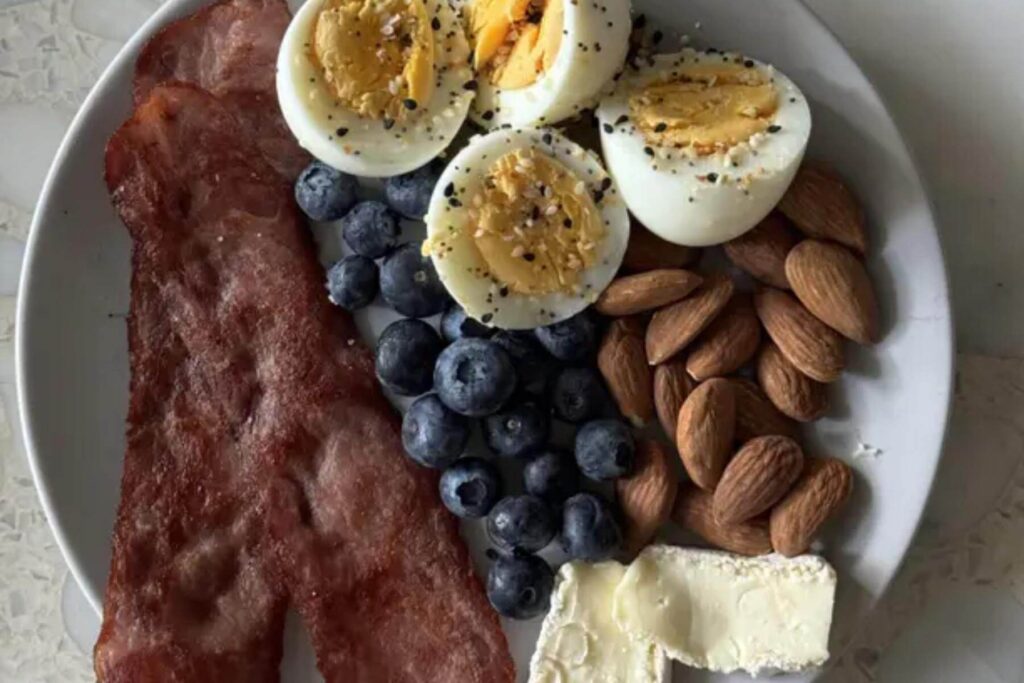
Getting your diet right is just as important as hitting the gym, and it can make all the difference in achieving your fitness goals, especially for women over 40.
Importance of Protein:
First things first, protein is your best friend when it comes to muscle repair and growth. Aim for about 1 gram per pound of body weight, and you’re set. Not only does this help repair muscle after tough workouts, but it also fuels new growth, keeping you strong and on track with your fitness goals.
I highly recommend counting macros, especially if you’re new to meal planning and setting nutrition goals. I have a simple guide that teaches you exactly how: How to Count Macros the Easy Way: Complete Beginner’s Guide.
Balancing Calories:
Want to lose fat? You’ll need a slight calorie deficit. Looking to gain muscle? Time for a surplus. If you’re just easing back into the gym, don’t overcomplicate it—stick to your workout plan and hit your protein targets. Simple.
Don’t forget Fats and Carbs:
Protein’s the star, but fats and carbs play supporting roles. Healthy fats keep your hormones in check and provide energy. Carbs? They fuel your workouts and help with recovery. Keep your macros balanced, and you’ll feel the difference in energy and progress.
Related: The Best Macro-Friendly Grocery List For Anti-Aging
Recovery & Rest: Don’t Skip This
I get it—starting a new routine is exciting, and you’re eager to go all in. But here’s the thing: muscles grow during rest, not just when lifting.
This is especially true for women over 40, where hormone changes and recovery rates mean rest days are critical.
Overdoing it without enough recovery can leave you feeling worn out, raise your cortisol levels, and actually hold back your progress. Worse, it can lead to injuries. So, listen to your body and give it the necessary downtime to stay strong, healthy, and injury-free.
Consistency Is Your Best Friend
Finally, remember that sticking to your training and diet is crucial.
In the early stages of resistance training (around the first 4 sessions), most muscle growth comes from muscle damage, while longer-term strength gains are primarily due to your nervous system adapting to the lifting.
After 6 to 10 weeks of consistent training, muscle growth becomes the main focus. Source: Maximizing Muscle Hypertrophy: A Systematic Review of Advanced Resistance Training Techniques and Methods.
Building a strong, lean body after 40 doesn’t require elaborate training programs or taking over your life—just a smart plan, consistent effort, compound movements with progressive overload, and proper rest and nutrition.
A solid weight training routine, especially if you’re a women over 40 , will boost metabolism and can transform how you feel and move every day.
Ready to Transform Your Body in 8 Weeks?
Build muscle, lose fat, and feel stronger than ever by forming habits that last with the Fit Forever Method—start your journey today!

